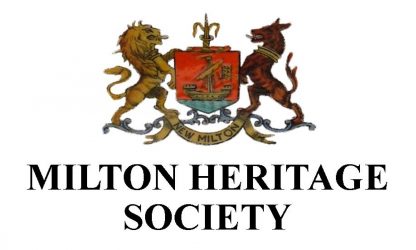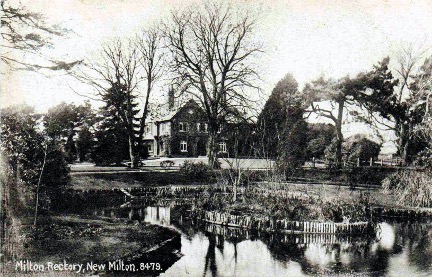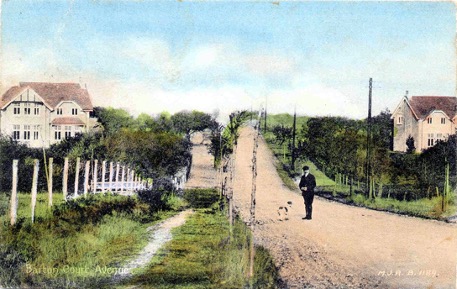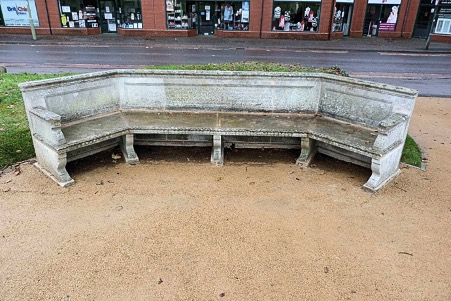In New Milton on the 26th of September 1920 the War Memorial was unveiled and dedicated and the Recreation Ground (‘The Rec’) was given to the people of Milton Parish, free of debt and for their use. The man behind this was the Reverend John Edward Kelsall. That was not his only contribution to New Milton. He made a lasting impact in other areas. Who was the Reverend Kelsall?
Early Life
John Edward Kelsall was born in Fareham, Hampshire on 5th January 1864. His father William, was a solicitor, whilst his mother Ellen, was the daughter of a London based publisher. He had two sisters. He studied at Rugby where he was known as ‘Joe’. He went on to Balliol College Oxford where he gained an Undergraduate degree in 1885 and a M.A. in 1889. He had studied law for a year at Oxford before deciding to take Holy Orders. He was ordained in 1889 and became the Curate of Holy Trinity Church, Wavertree from 1889 until 1893.
This period in history was near the end of an age when country clerics were well educated and had a good income from tithes or rents on land depending on their location. The role of a clergyman in the 150 years leading up to Reverend Kelsall arriving in Milton Parish was not particularly taxing. This resulted in many clerics doing extraordinary things for the benefit of the human race. In addition to their religious role in the community and working to improve the living conditions of the working class in their parishes they became inventors, mathematicians, scientists, botanists, dog breeders, pioneering hot air balloonists and authors amongst other occupations.
In 1893 Reverend Kelsall returned to Hampshire when he became the vicar of East Boldre from 1893 to 1897. Whilst at East Boldre he wrote about the parish in the ‘New Forest Magazine’. He had always loved nature and natural history. As well as highlighting religious matters he also recorded the local flora and fauna he had found in around the area. He continued to do this when he became the Rector at Milton Parish in 1897. His parish magazines in Milton contained snippets of local news in a time before the New Milton Advertiser (first published in 1928) and information about sighting of birds and animals. He also had a paragraph written in French to assist those pupils who were studying the language under his direction.
Milton Parish.
John Edward Kelsall was a lifelong bachelor. When he moved to Milton Parish in 1897, he lived in the rectory with his mother and two sisters. To put this period into local historical context, it was only 9 years previously that the first train had steamed into the new station 1 mile north east of Milton Village. In 1890 the first sale of plots of land from the Fernhill Manor Estate had opened up the area for development. This was increased when the Barton Court Estate was sold for development in a number of sales from 1894 onwards. In 1896 the town’s name ‘New Milton’ had been adopted. Reverend Kelsall had arrived in what was still very much a small rural village but was growing rapidly.
He threw himself into life in the local community and was involved in many ventures to enhance and benefit the area. He started fund raising for an Anglican chapel in Ashley. By 1904 there was enough money to construct a corrugated iron chapel in Ashley Common Road. It became known as St Peter’s in 1915. It was not until 1957 that the present brick-built church was constructed to replace the 1904 original chapel.
Reverend Kelsall also assisted the villagers of Bashley in creating a daughter church in the village. St John’s church was constructed of brick and consecrated in 1910 and is still in use today.
History of Milton Parish
In 1904 he co-authored a brief history of Milton village called ‘Miltoniana’. The source material was largely the parish notes held in the vestry. The history begins in 1654 with the oldest records in the parish then available to Reverend Kelsall.
He records details of the poor of the parish and the early forms of welfare available to them. This includes the creation of a poorhouse and its replacement after it had burnt down. There is a large amount of information relating to the poor including the names of some of the destitute and the amounts that they were paid.
‘Miltoniana’ reproduces details such as the lists of Parish officers, churchwardens and overseers. In 1810 there was a list of which Miltonians were sat in the various pews of St Mary Magdalene Church. These are valuable records of the names of some of the village inhabitants in a time before the first census.
There are records of doctors’ fees giving details of what they treated the patients for. These include an intriguing payment in 1825 for the Parish Doctor, Arthur W. Goddard. “June 3rd, extracting Ball [musket or pistol shot] from Jas. Read. June 5th, Attending Coroner. June 6thExamining body of James Reade, and attending Jury”. Perhaps this was related to smuggling?
The book records the details of parish expenses such as road and bridge maintenance and surveying of local land. In addition, it shows that the church choir were paid in beer by detailing some bills from both the George Inn and The Wheatsheaf. On March 10th, 17th and 25th 1813 the George Inn provided 5 pots of beer at 2 shillings and 6 pence a time.
We get a glimpse of the poverty of the time for the average worker as there is a list of ‘Mary Wallis’ Goods and Chattels taken the 5th day of May 1808’. It shows poor Mary had pitifully few items to her name.
‘Miltoniana’ is of great historical value for Milton Parish. The Reverend Kelsall and Alexander Paris have provided a lasting historical legacy for us.
Tree Lined Avenue and Road.
Another lasting legacy that is linked to Reverend Kelsall is the aesthetic appearance of Barton Court Road and Barton Court Avenue. They were created with the aid of a surveyor’s ruler when the Barton Court Estate was sold off for development in 1894. They appear on the Ordnance Survey maps in the late 1890s linking Station Road with the cliff top and beach.
It was John Edward Kelsall who started planting the trees along both the road and avenue to enhance the views towards the cliff tops. He encouraged other residents to fill in gaps and add to the existing specimens. This probably began just before the First World War.
In the parish magazine of December 1915 Reverend Kelsall writes that “some more memorial trees now stand alongside the Belgian tree in the “Avenue des Nations”, planted by the representatives of 4 Indian nations, namely Jamadar Sita Ram (Marhatta) Niak Gobar Singh (Garwali), Niak Makand Singh (Sikh) and Sepoy Fateh Noor (Muslman). Two European nations and the English army were represented at the planting ceremony, and a few words were said in three languages of India”. The soldiers were patients at the Indian Army Convalescent Depot in Barton 1914 to 1916.
In a post war parish magazine note Reverend Kelsall once again appealed to local residents to fill in the gaps along the tree line. He wrote “If the Avenue (for it is really all one avenue) were bordered with fine, well grown and healthy trees, it would be an even more striking feature of the place than it is now”.
He goes on to give us a clue as to where the Indian and Belgian planted trees were located when he wrote “The ash tree near Bykanor House was planted by a Belgian refugee during the Great War […] and three sycamores near the top of the Avenue were planted by Indian soldiers during the same period”. Study of the Ordnance Survey maps of the period shows that Bykanor House is halfway along Barton Court Road. There is a pollarded Ash tree outside the house today. The Indian’s sycamore trees must have been nearby.
The War Memorial and ‘Rec’ Ground.
The legacy that Reverend Kelsall has left us that is probably most appreciated is the War Memorial and the Recreation Ground, known to most in Milton as ‘The Rec’. In World War One, Milton Parish had 83 men killed. In a small rural with a population in 1914 of approximately 2700 this was a terrible loss. Miltonians if not related to a casualty probably would have known them from school, or sports teams or work. In addition, many men came back to New Milton, wounded both mentally and physically. The post war casualties are largely unacknowledged.
Reverend Kelsall saw that there was a real need in the parish for a focal point for remembrance which would help to bring closure to those grieving. He set up a collection fund with the intent to erect a memorial recording the names of those who had lost their lives. The fund would also pay to buy land that could be used as a Recreation Ground. Reverend Kelsall and a local pharmacist, Mr. Matterson, organised the fund and raised £850.
After some difficulties they managed to purchase a large field which was part of Haywards Farm in the Whitefield area of the town just to the west of Station Road. There was not quite enough money to pay for the land all the way up to what is now Whitefield Road. Mr Matterson purchased the remaining plots and had it converted into tennis courts and a bowling green which he gave to the town.
On the 26th of September 1920 the War Memorial was unveiled to a large crowd including veterans, boy scouts, girl guides, school children and locals. The Reverend A.C.G. Rendall in his address to the crowd said that the cross represented the fallen men of Milton and that they were not forgotten. Reverend Kelsall announced that the ground had been given to the town, debt free “to be used henceforth for the good of the whole parish”. He went on to say that he did not apologise for naming the field a ‘Recreation Ground’ since he wanted to see people “re-created” by sport. He believed that when people were “out of health, despondent or ill-humoured” they could be “restored to health, cheerfulness and good temper” by using the facilities. His sermon was entitled ‘A Garden of Memory’ in which he emphasised the benefits of the site and compared the Memorial Cross with a nearby captured trophy of a German artillery gun.
Post War.
After the war, Reverend Kelsall continued to work for the benefit of the town. He raised funds to take over a laundry on the junction of Gore Road and Old Milton Road. He turned it into the Milton Institute and created the first library for the town. He managed to persuade the local wealthy landowners and businessmen to donate books to the library. He bequeathed his own book collection to the library.
In 1924 at the age of 60 Reverend Kelsall was diagnosed with an incurable disease. He had just weeks to live. The last entry he wrote in his diary was Fiat Tua Voluntas (Thy Will be Done). He died on 11th of October 1924. His body was cremated and his ashes scattered on his mother’s grave in Woking.
The Reverend John Edward Kelsall is commemorated in New Milton with a stone bench that is located close to the War Memorial. Perhaps next time you are passing by you could spare a thought for a truly good man who did so much to enhance Milton Parish.
This article was written by Nick Saunders, Chairman of the Milton Heritage Society. It was first published in the New Milton Advertiser and Lymington Times on September 25th 2020.






